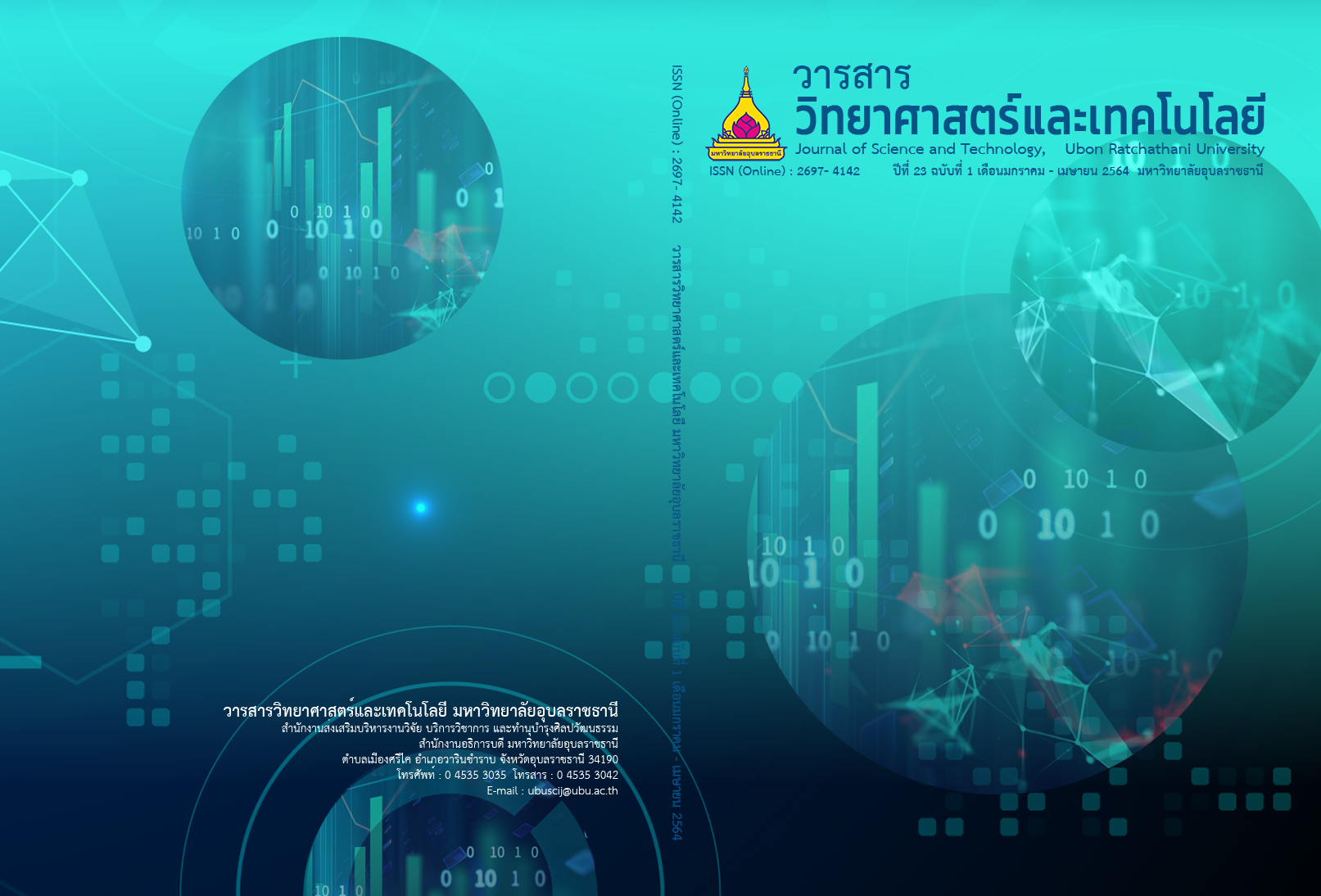การสกัดเพกทินจากเปลือกทุเรียนเพื่อนำไปใช้ในการผลิตแยมจากสละและระกำ ที่มีราคาตกต่ำในจังหวัดจันทบุรี
Main Article Content
บทคัดย่อ
งานวิจัยนี้ได้สกัดเพกทินจากเปลือกทุเรียนพันธุ์หมอนทองด้วยกรดไฮโดรคลอริกและนำมาผลิตแยมจากสละและระกำที่มีราคาตกต่ำในจังหวัดจันทบุรี โดยนำเพกทินที่สกัดได้มาหาค่าผลผลิตร้อยละและวิเคราะห์องค์ประกอบทางเคมีเปรียบเทียบกับเพกทินทางการค้า พบว่าเพกทินจากเปลือกทุเรียนมีค่าผลผลิตร้อยละ 8.83 มีปริมาณความชื้นร้อยละ 10.29 และเถ้าร้อยละ 15.37 ซึ่งสูงกว่าเพกทินทางการค้า มีปริมาณกรดกาแลคทูโรนิกร้อยละ 46.11 และเมทอกซิลร้อยละ 13.39 ต่ำกว่าเพกทินทางการค้า จากนั้นนำเพกทินที่ได้ไปใช้ในการผลิตแยม ทำการประเมินคุณภาพทางประสาทสัมผัสของแยมที่ผลิตได้ พบว่าแยมสละที่ใช้เพกทินจากเปลือกทุเรียนเป็นส่วนผสมได้รับการยอมรับสูงที่สุด ในด้าน กลิ่น รสชาติ เนื้อสัมผัส และความชอบโดยรวม ซึ่งไม่แตกต่างจากการใช้เพกทินทางการค้าอย่างมีนัยสำคัญทางสถิติ (p>0.05) ในขณะที่แยมระกำที่ใช้ เพกทินจากเปลือกทุเรียนนั้นมีความแตกต่างอย่างมีนัยสำคัญทางสถิติ (p<0.05) กับการใช้เพกทินทางการค้า แสดงให้เห็นว่าเปลือกทุเรียนสามารถนำมาผลิตเพกทินได้ เป็นการใช้วัสดุเหลือทิ้งทางการเกษตรให้เกิดประโยชน์สูงสุด และเพิ่มมูลค่าให้แก่สละและระกำที่มีราคาตกต่ำโดยนำมาทำแยมและใช้เพกทินจากเปลือกทุเรียนเป็นส่วนผสม
Article Details
บทความที่ได้รับการตีพิมพ์เป็นลิขสิทธิ์ของ วารสารวิทยาศาสตร์และเทคโนโลยี มหาวิทยาลัยอุบลราชธานี
ข้อความที่ปรากฏในบทความแต่ละเรื่องในวารสารวิชาการเล่มนี้เป็นความคิดเห็นส่วนตัวของผู้เขียนแต่ละท่านไม่เกี่ยวข้องกับมหาวิทยาลัยอุบลราชธานี และคณาจารย์ท่านอื่นๆในมหาวิทยาลัยฯ แต่อย่างใด ความรับผิดชอบองค์ประกอบทั้งหมดของบทความแต่ละเรื่องเป็นของผู้เขียนแต่ละท่าน หากมีความผิดพลาดใดๆ ผู้เขียนแต่ละท่านจะรับผิดชอบบทความของตนเองแต่ผู้เดียว
เอกสารอ้างอิง
[2] Grassino, A.N. and et al. 2016. Utilization of tomato peel waste from cannin Factory as a potential source for pectin production and application as tin corrosion inhibition. Food Hydrocolloids. 52: 265-274.
[3] Espitia, P.J.P. and et al. 2014. Edible films from pectin: physical-mechanical and antimicrobial properties-a review. Food Hydrocolloids. 35: 287-296.
[4] Thai Customs. Information service for importers and exporters. http://www.cus toms.go.th/statistic_report.php?tab=by_tariff_ classification. Accessed 13 January 2021. (In Thai)
[5] Baothong, E. 2019. Optimization for pectin extracting procession from coconut coir (Cocosnuclifera Linn.) In: Proceedings of the 6th National Conference Nakhonratchasima College, 30 March 2019. Nakohonratchasima, Thailand. (In Thai)
[6] Suwannarat, Y., Sawasdikarn, J. and Suwannarat, R. 2020. Extraction and application of pectin from durian rind. Rajabhat Rambhai Barni Research Journal. 13(2): 25-37. (In Thai)
[7] Colodel, C. and et al. 2018. Extraction of Pectin from Ponkan (Citrus reticulate Blanco cv. Ponkan) Peel: optimization and structural characterization. International Journal of Biological Macromolecules. 117: 385-391.
[8] Jafari, F., Khodaiyan, F., Kiani, H. and Hosseini, S.S. 2016. Pectin from carrot pomace: optimization of extraction and physicochemical properties. Carbohydrate Polymers. 157: 1315-1322.
[9] Office of Agricultural Economics. Durian king of Thai fruit like foreigners. http://www.tpso. moc.go.th/sites/default/files/thueriiyn_240863.pdf. Accessed 13 January 2021. (In Thai)
[10] Putri, R.D.A. and Kurniyati, Z. 2016. Effect of sodium chloroacetate towards the synthesis of CMC (carboxymethyl cellulose) from durian (Durio zibethinus) peel cellulose. International Journal of Innovative Research in Advanced Engineering. 3(3): 28-32.
[11] Baothong, E. 2018. Utilization of durian rind and coconut husk for pectin extraction. Journal of Research Unit on Science, Technology and Environment for Learning. 9(2): 200-210. (In Thai)
[12] Lenanurak, S. 1992. Fruit and vegetables processing. Chiang mai: Chiang mai University Press. (In Thai)
[13] Unhasirikul, M., Narkrugsa, W. and Naranong, N. 2013. Sugar production from durian (Durio zibethinus Murray) peel by acid hydrolysis. African Journal of Biotechnology. 12(33): 5244-5251.
[14] Ratchumpol, R. and Rattanapittayaporn, A. 2005. Extraction and characterization of pectin from Durian husks. Bangkok: Faculty of Science and Technology, Phranakhon Rajabhat University. (In Thai)
[15] AOAC. (2000). Official Method of Analysis. .Association of Official Analytical Chemistry.
[16] Dedduand, O. 2010. Comparison of extracted pectin from three kids of guava (Psidium guajava L.) to standard pectin. M.Sc. Thesis, Srinakharinwirot University. (In Thai).
[17] Singthong, J. and et al. 2004. Structural characterization, degree of esterification and some gelling properties of Krueo Ma Noy (Cissampelos pareira) pectin. Carbohydrate Polymers. 58: 391-400.
[18] Kyung, S.K. 2015. Homemade jam, sweet, juicy and fresh from fruits and vegetables, delicious, easy, organic. Bangkok: Amarin Printing and Publishing Public Company Limited. (In Thai).
[19] Larptansuphaphol, T., Thongkwan, P. and Songpromtip, S. 2013. Extraction of Pectin from Peels of Vegetables and Fruits. Agricultural Science Journal. 44(2)(Suppl.): 433-436. (In Thai).
20] Sukboonyasatit, D., Pornnikom, N. and Natyay, N. 2018. Chemical and physical properties of pectin from okra. Khon Kaen Agriculture Journal. 46(1)(Suppl.): 1418-1423.
[21] Wititsiri, S. 2014. The Comparison of pectin quantities from stringy pulp of nanga jackfruit (Juampa Krop) between hot water and high vapor pressure. Journal of Yala Rajabhat University. 9(2): 95-112. (In Thai).
[22] Steven, N., Philip, E.S. and Mathew, K. 1977. Citrus Science and Technology. California: University of California.


